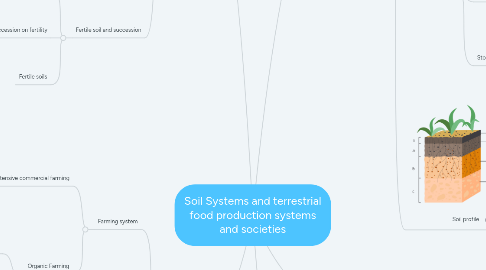
1. 5.2
1.1. Farming system
1.1.1. Intensive commercial farming
1.1.1.1. Crop production
1.1.1.1.1. is based on economies of scale, where high inputs and technologies are employed to produce the highest yields at minimum production cost
1.1.1.2. High Environmental impacts
1.1.1.3. Both crops and animals can be commercially farmed with high inputs producing high yields.
1.1.2. Organic Farming
1.1.2.1. prohibits the use of genetically modified organisms (GMOs), chemical fertilizers and restricts the use of chemical pesticides.
1.1.2.2. Subsistence farming systems
1.1.2.3. Shifting agriculture
1.1.2.4. Nomadic herding
1.2. Food availability and choices
1.2.1. Food waste
1.2.2. Consumer choice
1.2.3. Demand for meat
1.3. Food production and sustainability
1.3.1. To feed a growing world population, large areas of land will continue to be farmed. However, as population numbers increase, the amount of space per capita is reduced.
1.3.2. Sustainable farming strategies
1.3.3. Legislation
1.3.4. Pollution management
1.3.5. Reduction of food waste
1.3.6. Growing indigenous crops
1.3.7. Polyculture farming
1.3.8. Reduction of meat consumption
2. 5.3
2.1. Threats to soil: Human activities
2.1.1. Urbanisation
2.1.2. Livestock overgrazing
2.1.3. Deforestation
2.1.4. Farming
2.1.5. Desertification
2.2. Soil conservation
2.2.1. Reducing water erosion
2.2.2. Use of Conventional tillage vs conservation tillage method
2.2.3. Reducing salinisation
2.2.4. Managing soil nutrient levels
2.2.5. Control grazing
2.3. Threat to soil
2.3.1. Physical degradation
2.3.1.1. This can include soil compaction from use of heavy farming machinery and animals
2.3.2. Wind erosion
2.3.2.1. The wind picks up the soil particles and carries them through the air.
2.3.3. Water erosion
2.3.3.1. Detachment
2.3.3.2. Transport
2.3.3.3. Deposition
2.3.4. Chemical degradation
2.3.4.1. Salinisation
2.3.4.2. Acidification
2.3.4.3. Nutrient depletion
2.3.4.4. Chemical pollution
2.4. Fertile soil and succession
2.4.1. Non-renewable resource
2.4.2. Role of succession on fertility
2.4.2.1. This decomposition process involves
2.4.2.1.1. Invertebrates
2.4.2.1.2. Fungi and bacteria
2.4.2.2. Biological activity within the soil contributes to mineralisation of dead organic matter (waste matter and dead organisms) which increases nutrient levels.
2.4.3. Fertile soils
3. 5.1
3.1. What is soil
3.1.1. minerals, organic matter, air and water
3.1.2. Primary functions
3.1.2.1. It is a medium for plant growth
3.1.2.2. It is a major water storage and purification system.
3.1.2.3. It provides a habitat
3.1.2.4. Soil modifies the atmosphere
3.1.3. Factors affecting soil
3.1.3.1. Climate
3.1.3.2. Parent material
3.1.3.3. Organisms
3.1.3.4. Relief
3.1.3.5. Time
3.1.4. .
3.2. Soil texture
3.2.1. .
3.3. Soil as a system
3.3.1. Inputs
3.3.1.1. Minerals
3.3.1.2. Organic matter
3.3.1.3. Gases
3.3.1.4. Water
3.3.2. Outputs
3.3.3. Processes, transfers and transformations
3.3.3.1. Leaching and evaporation
3.3.3.2. Decomposition
3.3.3.3. Weathering
3.3.4. Stores
3.3.4.1. Organic matter
3.3.4.2. Organisms
3.3.4.3. Nutrients
3.3.4.4. Air

